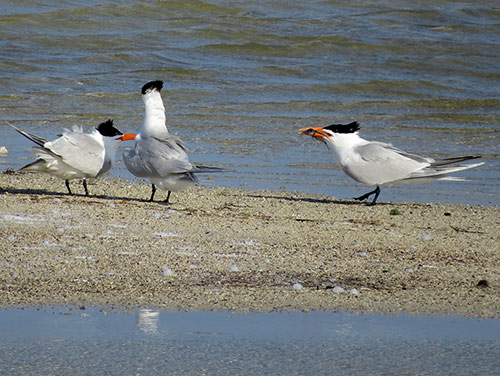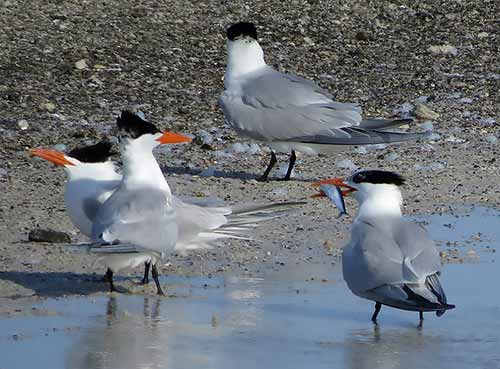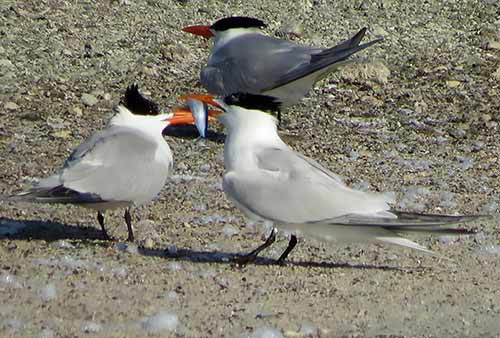The Secret Life of Terns
Tern Courtship & Mating Behaviors
On Bonaire, terns (and gulls) arrive en masse in March to begin their courtship and mating.
They do not sneak in, one by one or two by two, but they seem to arrive en masse! One day they are not here, and it seems that, overnight, the island is mobbed by the arriving seabirds as they prepare for their tern courtship and mating.
While North American birds who have wintered on Bonaire, or are passing through from wintering grounds further south, depart Bonaire for their northern breeding grounds, the gulls and terns arrive from South America to escape the southern hemisphere’s winter and to breed on Bonaire.
Bonaire offers prime breeding grounds, with many of the tern species preferring the Pekelmeer area, in the area of Bonaire’s salt pans to play out the drama of their courtship and subsequent mating.
The majority of terns that we see here on Bonaire are Royal Terns (we also have a small year-round population), Least Terns, Sandwich Terns (Cayenne subspecies), and Common Terms. Occasionally other terns are observed as well.
Tern courtship and mating rituals.
Tern courtship may includes offerings of fish and posturing.
Tern courtship feeding.
Courtship feeding is frequently seen in terns. In an effort to attract a suitable mate, the male tern may carry a fish (always carried crosswise in the mouth) and present it to a prospective female.
The size of the proffered fish might be a determining factor as to whether the female accepts the food or not. In one study of Royal Terns, on 23 occasions in which the female accepted the food, the proffered fish was 7 cm. in length or longer. In seven refusals of food, the fish was only 5 cm in length or smaller and very slender. This leads to speculation that the function of courtship feeding may give the females the opportunity to assess potential mates as future providers for chicks.
Tern courtship posturing.
Males were busy with other courtship displays, including some high-stepping “Happy Feet” dancing in front of females, as well as unmistakable posturing of the male, with his neck extended and slightly back, and with the bends of the wings out like a skirt.
The female might also posture in a similar manner, but at a lower height than the male. Disputes between males are often observed with raucous cries and territorial displays.
When close to mounting a female, the male will begin to “herd” the female, walking quickly with their lateral sides touching. As soon as the female sinks downward, with her bill upward, the male will mount her by standing on her shoulders, with his wings alight to balance himself.
- Use your vehicle as a blind,
- Use a spotting scope or binoculars.
- Do follow local regulations that prohibit you from entering the area east of the road.
- Keep your distance. If nests with eggs are in the area, your actions could scare the female from the nest, allowing her eggs to “cook” in the tropical sun.
Quick facts and current status of Bonaire’s most commmonly observed terns.
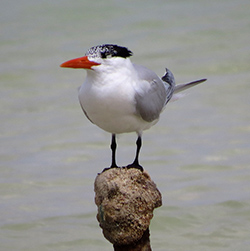
Royal Tern
(Thalasseus maximus)
Diet: Feeds on small fish, but they also eat insects, shrimp, and crabs
Breeding: Lays 1 or 2 eggs
Status: Least Concern
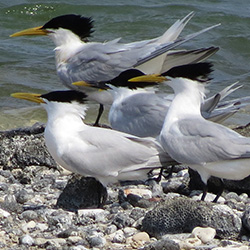
Sandwich Tern (Cayenne)
(Thalasseus sandvicensis eurygnathus)
Diet: Feeds by plunge-diving for fish, almost invariably from the sea
Breeding: Lays 1 to 3 eggs
Status: Least Concern
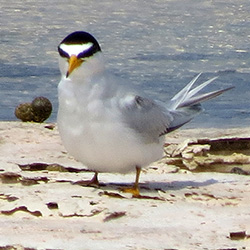
Least Tern
(Sternula antillarum)
Diet: Feeds by plunge-diving for fish, almost invariably from the sea
Breeding: Lays 2 to 3 eggs
Status: Least Concern, but populations are decreasing
About the author
Susan has been living on Bonaire for over 30 years. She is a certified bird guide, a PADI SCUBA Diving Master Instructor, and an underwater and topside photographer.

Get in touch with Susan
Contact Susan via email, Facebook Messenger, call Susan or use the online form below.
If you have any questions about your Bonaire birding tour, feel free to contact Susan for answers. She is always willing to go into more detail about routes or the best times for a tour based on your personal preferences. Tours can be tailored to your interests, whether that be birds, photography, or both!
It is also a good idea to do some homework on the birds of Bonaire before you come. Knowing a little about the birds you might encounter on your tour will make your experience even more enjoyable!
Be sure to check out these resources for birding on Bonaire. Also, reading the Bird Blog will introduce you to the birds that might be observed on Bonaire.
Get In Touch
Get in touch with Susan to check availability for the dates you are visiting Bonaire.
Consent: By using this form you agree with the storage and handling of your data by this website.

